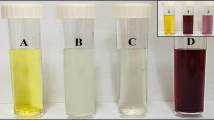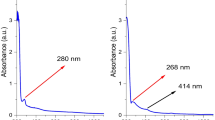Abstract
In this study, a biological approach has carried out to develop the polymer-based nanoparticles using a bioflavonoid of hesperidin. This formulation has been attempted and established for its biomedical application in cancer treatment. Hesperidin loaded PLGA nanoparticles (Hes-PLGA-NPs) were processed by oil in water single emulsion solvent evaporation technique and the physiochemical traits were characterized by dynamic light scattering (DLS), transmission electron microscopy (TEM), fourier transform infrared spectroscopy (FTIR), XRD and NMR analysis. DLS and TEM analysis revealed that the preparation yielded a spherical shaped nanoparticle with an average measure of 38.4 nm. The XRD spectrum showed a crystalline type of nanoparticles. The FTIR and NMR investigation exposed that the PLGA also serves up as capping or switching material for pH-dependent drug release. Furthermore, the cationic natures of Hes-PLGA-NPs easily penetrate cancerous cells and efficiently repressed the growth in acidic conditions. Taking into account, the findings of in vitro studies in HEp-2 cell suggested that bioformulated Hes-PLGA-NPs are more competent than native hesperidin and might be used as a potent anti-cancer candidate. Further studies are warranted to expose the toxicity and molecular level mechanisms involved in the anti-cancer activity of the synthesized Hes-PLGA-NPs as nanomedicine.
Grapic Abstract











Similar content being viewed by others
Change history
31 October 2020
The authors noticed an inadvertent error in our article “Bioformulated Hesperidin-Loaded PLGA Nanoparticles Counteract the Mitochondrial-Mediated Intrinsic Apoptotic Pathway in Cancer Cells”.
References
A.K. Sah, A. Vyas, P.K. Suresh, B. Gidwani, Application of nanocarrier-based drug delivery system in treatment of oral cancer. Artif. Cells Nanomed. Biotechnol. 46, 650–657 (2018)
M. Sengar, A. Fundytus, W.M. Hopman, H. Malhotra, S. Gupta, C. Pramesh, N. Hammad, R. Sullivan, V. Vanderpuye, B. Seruga, Medical oncology in India: workload, infrastructure, and delivery of care. Indian J. Med. Paediatr. Oncol. 40, 121 (2019)
K. Suresh, S. Manoharan, M.A. Vijayaanand, G. Sugunadevi, Chemopreventive and antioxidant efficacy of (6)-paradol in 7, 12-dimethylbenz (a) anthracene induced hamster buccal pouch carcinogenesis. Pharmacol. Rep. 62, 1178–1185 (2010)
J.H. Meurman, Oral microbiota and cancer. J. Oral Microbiol. 2, 5195 (2010)
D.M. Cohan, S. Popat, S.E. Kaplan, N. Rigual, T. Loree, W.L. Hicks Jr., Oropharyngeal cancer: current understanding and management. Curr. Opin. Otolaryngol. Head Neck Surg. 17, 88–94 (2009)
F. Danhier, E. Ansorena, J.M. Silva, R. Coco, A. Le Breton, V. Préat, PLGA-based nanoparticles: an overview of biomedical applications. J. Control. Release. 161, 505–522 (2012)
D.N. Kapoor, A. Bhatia, R. Kaur, R. Sharma, G. Kaur, Dhawan, PLGA: a unique polymer for drug delivery. Ther. Deliv. 6, 41–58 (2015)
E. Swider, O. Koshkina, J. Tel, L.J. Cruz, I.J.M. de Vries, M. Srinivas, Customizing poly (lactic-co-glycolic acid) particles for biomedical applications. Acta Biomater. 73, 38–51 (2018)
I. Bala, S. Hariharan, M.R. Kumar, PLGA nanoparticles in drug delivery: the state of the art. Crit Rev Ther Drug. 21, 387 (2004)
V. Kuntić, J. Brborić, I. Holclajtner-Antunović, S. Uskoković-Marković, Evaluating the bioactive effects of flavonoid hesperidin: a new literature data survey. Vojnosanit. Pregl. 71, 60–65 (2014)
A. Garg, S. Garg, L. Zaneveld, A. Singla, Chemistry and pharmacology of the citrus bioflavonoid hesperidin. Phytother. Res. 15, 655–669 (2001)
B. Ameer, R.A. Weintraub, J.V. Johnson, R.A. Yost, R.L. Rouseff, Flavanone absorption after naringin, hesperidin, and citrus administration. Clin. Pharmacol. Ther. 60, 34–40 (1996)
A. Garg, S. Garg, L.J. Zaneveld, A.K. Singla, Chemistry and pharmacology of the citrus bioflavonoid hesperidin. Phytothe. Res. 15(8), 655–669 (2001)
R. Ikan, Natural Products: A Laboratory Guide (Academic Press, New York, 1991)
A. Roohbakhsh, H. Parhiz, F. Soltani, R. Rezaee, M. Iranshahi, Molecular mechanisms behind the biological effects of hesperidin and hesperetin for the prevention of cancer and cardiovascular diseases. Life Sci. 124, 64–74 (2015)
R. Bartoszewski, A. Hering, M. Marszałł, J.S. Hajduk, S. Bartoszewska, N. Kapoor, K. Kochan, Ochocka. Mangiferin has an additive effect on the apoptotic properties of hesperidin in Cyclopia sp. tea extracts. PloS ONE 9(3), e92128 (2014)
H.J. Park, M.J. Kim, E. Ha, J.H. Chung, Apoptotic effect of hesperidin through caspase3 activation in human colon cancer cells, SNU-C4. Phytomedicine. 15(1–2), 147–151 (2008)
T. Tanaka, T. Tanaka, M. Tanaka, T. Kuno, Cancer chemoprevention by citrus pulp and juices containing high amounts of β-cryptoxanthin and hesperidin. J. Biomed. Biotechnol. (2012). https://doi.org/10.1155/2012/516918
J. Zhao, Y. Li, J. Gao, Y. De, Hesperidin inhibits ovarian cancer cell viability through endoplasmic reticulum stress signaling pathways. Oncol. Lett. 14, 5569–5574 (2017)
S. Vijayalakshmi, A.V. Mariadoss, V. Ramachandran, V. Shalini, B. Agilan, C.C. Sangeetha, P. Balu, V.S. Kotakadi, V. Karthikkumar, Ernest. Polydatin encapsulated poly [lactic-co-glycolic acid] nanoformulation counteract the 7, 12-dimethylbenz [a] anthracene mediated experimental carcinogenesis through the inhibition of cell proliferation. Antioxidants. 8(9), 375 (2019)
M.B. Hansen, S.E. Nielsen, K. Berg, Re-examination and further development of a precise and rapid dye method for measuring cell growth/cell kill. J. Immunol. Methods 119, 203–210 (1989)
S.H. Mahassni, R.M. Al-Reemi, Apoptosis and necrosis of human breast cancer cells by an aqueous extract of garden cress (Lepidium sativum) seeds. Saudi. J. Biol. Sci. 20, 131–139 (2013)
S. Vrignaud, J.-P. Benoit, P. Saulnier, Strategies for the nanoencapsulation of hydrophilic molecules in polymer-based nanoparticles. Biomaterials 32, 8593–8604 (2011)
M.A. Anand, K. Saravanakumar, S. Anbazhagan, K. Venkatachalam, M.H. Wang, Folic acid functionalized starch encapsulated green synthesized copper oxide nanoparticles for targeted drug delivery in breast cancer therapy. Int. J. Biol. Macromol. 164, 2073 (2020)
G.M. Sulaiman, H.M. Waheeb, M.S. Jabir, S.H. Khazaal, Y.H. Dewir, Y. Naidoo, Hesperidin loaded on gold nanoparticles as a drug delivery system for a successful biocompatible, anti-cancer, anti-inflammatory and phagocytosis inducer model. Sci Rep 10, 9362 (2020)
R. Singh, P. Kesharwani, N.K. Mehra, S. Singh, S. Banerjee, N.K. Jain, Development and characterization of folate anchored Saquinavir entrapped PLGA nanoparticles for anti-tumor activity. Drug Dev Ind Pharmacy 41(11), 1888–1901 (2015)
S.H. Ali, G.M. Sulaiman, M.M. Al-Halbosiy, M.S. Jabir, A.H. Hameed, Fabrication of hesperidin nanoparticles loaded by poly lactic co-glycolic acid for improved therapeutic efficiency and cytotoxicity. Artif. Cells Nanomed. Biotechnol. 47(1), 378–394 (2019)
W. Klöpffer, Introduction to Polymer Spectroscopy (Springer, Frankfurt, 1984)
P. Lakshmi, K. Rajesh, U. Devan, K. Mahesh, G. Nithya, J. Antony, Encapsulation of doxorubicin in PLGA nanoparticles enhances cancer therapy. Clin. Oncol. 2, 1–6 (2017)
R. Singh, P. Kesharwani, N.K. Mehra, S. Singh, S. Banerjee, N.K. Jain, Development and characterization of folate anchored Saquinavir entrapped PLGA nanoparticles for anti-tumor activity. Drug Dev. Ind. Pharmacy 41(11), 1888–1901 (2015)
R.A. Jain, The manufacturing techniques of various drug loaded biodegradable poly (lactide-co-glycolide)(PLGA) devices. Biomaterials. 21(23), 2475–2490 (2000)
S. Majumdar, R. Srirangam, Solubility, stability, physicochemical characteristics and in vitro ocular tissue permeability of hesperidin: a natural bioflavonoid. Pharm. Res. 26, 1217–1225 (2009)
S.A. Cho, S.R. Cha, S.M. Park, K.H. Kim, H.G. Lee, E.Y. Kim, D. Lee, G. Khang, Effects of hesperidin loaded poly (lactic-co-glycolic acid) scaffolds on growth behavior of costal cartilage cells in vitro and in vivo. J. Biomater. Sci. Polym. Ed. 25, 625–640 (2014)
D.S. Wishart, C. Knox, A.C. Guo, R. Eisner, N. Young, B. Gautam, D.D. Hau, N. Psychogios, E. Dong, S. Bouatra, R. Mandal, HMDB: a knowledgebase for the human metabolome. Nucleic Acids Res 37(Database issue), D603–D610 (2009). https://doi.org/10.1093/nar/gkn810
Y.S. Jadeja, K.M. Kapadiya, H.J. Jebaliya, A.K. Shah, R.C. Khunt, Dihedral angle study in Hesperidin using NMR spectroscopy. Magn. Reson. Chem. 55(6), 589–594 (2017)
J.L. Nieto, A.M. Gutierrez, Spectrosc. Lett. 19, 427–434 (1986)
V. Mishra, P. Kesharwani, N.K. Jain, Functionalized polymeric nanoparticles for delivery of bioactives. Nanobiomedicine 3, 91–123 (2014)
R. Singh, J.W. Lillard Jr., Nanoparticle-based targeted drug delivery. Exp. Mol. Pathol. 86, 215–223 (2009)
M. Ersoz, A. Erdemir, D. Duranoglu, D. Uzunoglu, T. Arasoglu, S. Derman, B. Mansuroglu, Comparative evaluation of hesperetin loaded nanoparticles for anticancer activity against C6 glioma cancer cells. Artif. Cells Nanomed. Biotechnol. 47, 319–329 (2019)
X. Chen, Z. Zhong, Z. Xu, L. Chen, Y. Wang, 2′,7′-Dichlorodihydrofluorescein as a fluorescent probe for reactive oxygen species measurement: forty years of application and controversy. Free Radic. Res. 44, 587–604 (2010)
G. Borges Bubols, D. da Rocha Vianna, A. Medina-Remon, G. von Poser, R.M. Lamuela-Raventos, V.L. Eifler-Lima, S. Cristina Garcia, The antioxidant activity of coumarins and flavonoids. Mini. Rev. Med. Chem. 13, 318–334 (2013)
A.V. Mariadoss, R. Vinayagam, B. Xu, K. Venkatachalam, V. Sankaran, S. Vijayakumar, S.R. Bakthavatsalam, S.A. Mohamed, E. David. Phloretin loaded chitosan nanoparticles enhance the antioxidants and apoptotic mechanisms in DMBA induced experimental carcinogenesis. Chem. Biol. Interact. 308, 11–19 (2019)
Y. Li, Z.-Z. Zhang, Sustained curcumin release from PLGA microspheres improves bone formation under diabetic conditions by inhibiting the reactive oxygen species production. Drug Des. Devel. Ther. 12, 1453 (2018)
F. Armutcu, S. Akyol, O. Akyol, The interaction of glutathione and thymoquinone and their antioxidant properties. Electron. J. Gen. Med. 15, em59 (2018)
R. Ahmed, M. Tariq, I.S. Ahmad, H. Fouly, A. Hasan, M. Kushad, Poly (lactic-co-glycolic acid) nanoparticles loaded with callistemon citrinus phenolics exhibited anticancer properties against three breast cancer cell lines. J. Food Qual. 1, 12 (2019)
N. Sharma, R.M. Kumari, N. Gupta, S. Nimesh, Plant based bioactive compounds as an alternative for cancer therapy. Cancer Ther. 3, 215 (2019)
R.H. Wijdeven, B. Pang, Y.G. Assaraf, J. Neefjes, Old drugs, novel ways out: drug resistance toward cytotoxic chemotherapeutics. Drug Resist. Updat. 28, 65–81 (2016)
S. Attoub, S. Sulaiman, K. Arafat, 14P Butein inhibits solid tumors cell viability, colony, and tumor growth via STAT3 signaling pathway and enhance the anti-cancer effects of Frondoside-A and camptothecin. Ann. Oncol. 30, i4 (2019)
A.A. Abd-Rabou, H.H. Ahmed, CS-PEG decorated PLGA nano-prototype for delivery of bioactive compounds: a novel approach for induction of apoptosis in HepG2 cell line. Adv. Med. Sci. 62, 357–367 (2017)
Author information
Authors and Affiliations
Corresponding author
Ethics declarations
Conflict of interest
On behalf of all authors, the corresponding author states that there is no conflict of interest.
Additional information
Publisher's Note
Springer Nature remains neutral with regard to jurisdictional claims in published maps and institutional affiliations.
Electronic supplementary material
Below is the link to the electronic supplementary material.
Rights and permissions
About this article
Cite this article
Balakrishnan, K., Casimeer, S.C., Ghidan, A.Y. et al. Bioformulated Hesperidin-Loaded PLGA Nanoparticles Counteract the Mitochondrial-Mediated Intrinsic Apoptotic Pathway in Cancer Cells. J Inorg Organomet Polym 31, 331–343 (2021). https://doi.org/10.1007/s10904-020-01746-9
Received:
Accepted:
Published:
Issue Date:
DOI: https://doi.org/10.1007/s10904-020-01746-9




